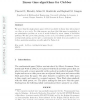533 search results - page 10 / 107 » Playing games with approximation algorithms |
AIIDE
2008
13 years 9 months ago
2008
Children do not learn the meanings of words from parsing and understanding gigabytes of text; instead meanings are learned from competent speakers who relate language to what'...
CORR
2007
Springer
13 years 7 months ago
2007
Springer
We prove that the single-player game clobber is solvable in linear time when played on a line or on a cycle. For this purpose, we show that this game is equivalent to an optimizat...
CROSSROADS
2007
13 years 7 months ago
2007
We analyze the complexity of the popular PlayStation 2 game, Katamari Damacy. In particular, we prove that playing Katamari Damacy optimally is NP-hard and that it cannot be appro...
VC
2008
13 years 7 months ago
2008
Illumination rendering including environment lighting, indirect illumination, and subsurface scattering plays for many graphics applications such as games and VR systems. However, ...
CAV
2007
Springer
14 years 1 months ago
2007
Springer
In 2005 we proposed the first efficient on-the-fly algorithm for solving games based on timed game automata with respect to reachability and safety properties. The first prototy...


